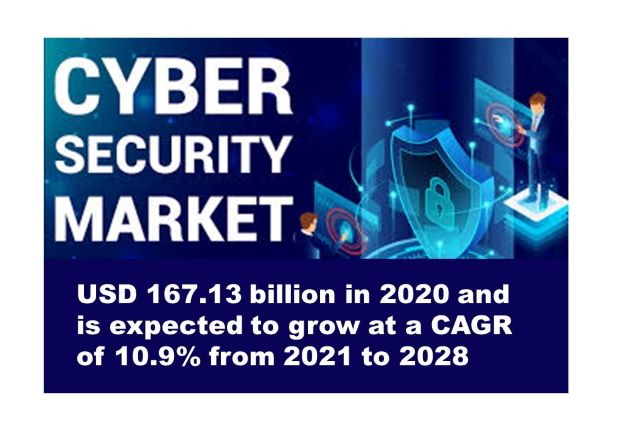The global cyber security market size was valued at USD 167.13 billion in 2020 and is expected to register a CAGR of 10.9% from 2021 to 2028.
Over the past year, it’s been impossible to ignore the rising tide of threats targeting government and commercial organisations around the world and the cyber security market is reacting. The frequency and intensity of cyber scams and crimes have increased over the last decade, resulting in huge losses for businesses.
The growth of the market can be attributed to the growing sophistication of cyber attacks and ss incidents of cyber crime increased significantly, businesses worldwide channeled their spending on advanced information security technologies to strengthen their in-house security infrastructure.
Ransomware alone, increased 148% year on year with an estimated 2.9 million ransomware attacks so far in 2021, Momentum Cyber reveals. Beyond the numbers, these attacks have manifested in significant and increasingly concerning ways.
There was the disruption of the flow of nearly half of the oil and gas to the East Coast of the United States with the shutdown of the Colonial Pipeline, the interruption of our food supply with an attack crippling of the Irish health system, and countless other attacks that never made the news. On top of that, we’ve seen supply chain attacks causing widespread impact on thousands of organisations worldwide and the European Union Cybersecurity Agency (ENISA) recently predicted a fourfold increase in supply chain attacks in 2021 over last year, warning that strong cybersecurity protection is no longer effective in defending against these types of attacks.
Commercial and government organisations are recognising the dire challenge at hand and investing significantly in cyber security technologies to combat these threats. Spend on global information security and risk management technologies in 2021 is projected to increase 12.4% to $150 billion.
With evolving threats comes a need for new, emerging technologies. These technologies can supplement technologies from some of our nation’s most prominent cyber security vendors, or they can stand alone to become the next wave of innovation in our industry.
IT analyst forecasts are unable to keep pace with the dramatic rise in cyber crime with a number of dramatic developments:
- The ransomware epidemic
- The proliferation of hackers-for-hire
- The refocusing of malware from PCs and laptops to smartphones and mobile devices
- The deployment of billions of under-protected Internet of Things (IoT) devices
- More sophisticated cyber attacks launching at businesses, governments, educational institutions and consumers
Total investment into cyber security skyrocketed in the first half of 2021, more than doubling over the same period last year. Investors poured $11.5 billion in total venture capital financing in 1H 2021, up from $4.7 billion in 1H 2020. Of the 430 total transactions, 36 were greater than $100 million. Categories like risk & compliance, data security, network & infrastructure security and incident response & threat intelligence captured the attention of investors.
M&A volume also saw a significant increase in the first half of 2021, with significant deals for companies in cloud security, security consulting, risk & compliance and more. Total M&A volume was more than four times what it was during the same period of 2020, with $39.5 billion in total deals in 1H 2021 across 163 total transactions. This total is up from $9.8 billion in 1H 2020 across 93 transactions.
The growing demand for solutions is anticipated to gain traction with cumulative investments from countries including Germany, France, India, Spain, South Korea, Italy, Canada and others. The increasing adoption of enterprise security solutions from manufacturing, banking, financial services, and insurance (BFSI) and healthcare is expected to drive market growth in the forthcoming years.
 This unprecedented challenge creates significant opportunities for the right investors with the domain expertise and operational know-how to identify the companies and entrepreneurs developing the disruptive technologies that will change the cyber security landscape.
This unprecedented challenge creates significant opportunities for the right investors with the domain expertise and operational know-how to identify the companies and entrepreneurs developing the disruptive technologies that will change the cyber security landscape.
Source: Cyber Security Intelligence


























